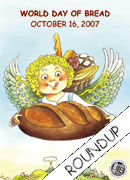World Bread Day Roundup is posted
[center] [/center] Zorra has posted the WBD 2007 roundup. There were so many entries (183 entries with more than 200 recipes) that she has divided the roundup into 4 parts:
[/center] Zorra has posted the WBD 2007 roundup. There were so many entries (183 entries with more than 200 recipes) that she has divided the roundup into 4 parts:
 [/center] Zorra has posted the WBD 2007 roundup. There were so many entries (183 entries with more than 200 recipes) that she has divided the roundup into 4 parts:
[/center] Zorra has posted the WBD 2007 roundup. There were so many entries (183 entries with more than 200 recipes) that she has divided the roundup into 4 parts: - Log in or register to post comments
- 3 comments
- View post
- ejm's Blog
 [/center]
I do love bread! It really is the staff of life, don't you think?
As far as I'm concerned, every day is bread day. We invariably have buttered toast each morning for breakfast. Sandwiches are not uncommon for lunch. Bread is often the starch we choose to go with dinner.
[/center]
I do love bread! It really is the staff of life, don't you think?
As far as I'm concerned, every day is bread day. We invariably have buttered toast each morning for breakfast. Sandwiches are not uncommon for lunch. Bread is often the starch we choose to go with dinner. [/center]
When people hear that I make virtually all our bread, they nod in approval and invariably ask what kind of bread machine I have. Here is how the conversation generally continues:
[/center]
When people hear that I make virtually all our bread, they nod in approval and invariably ask what kind of bread machine I have. Here is how the conversation generally continues: